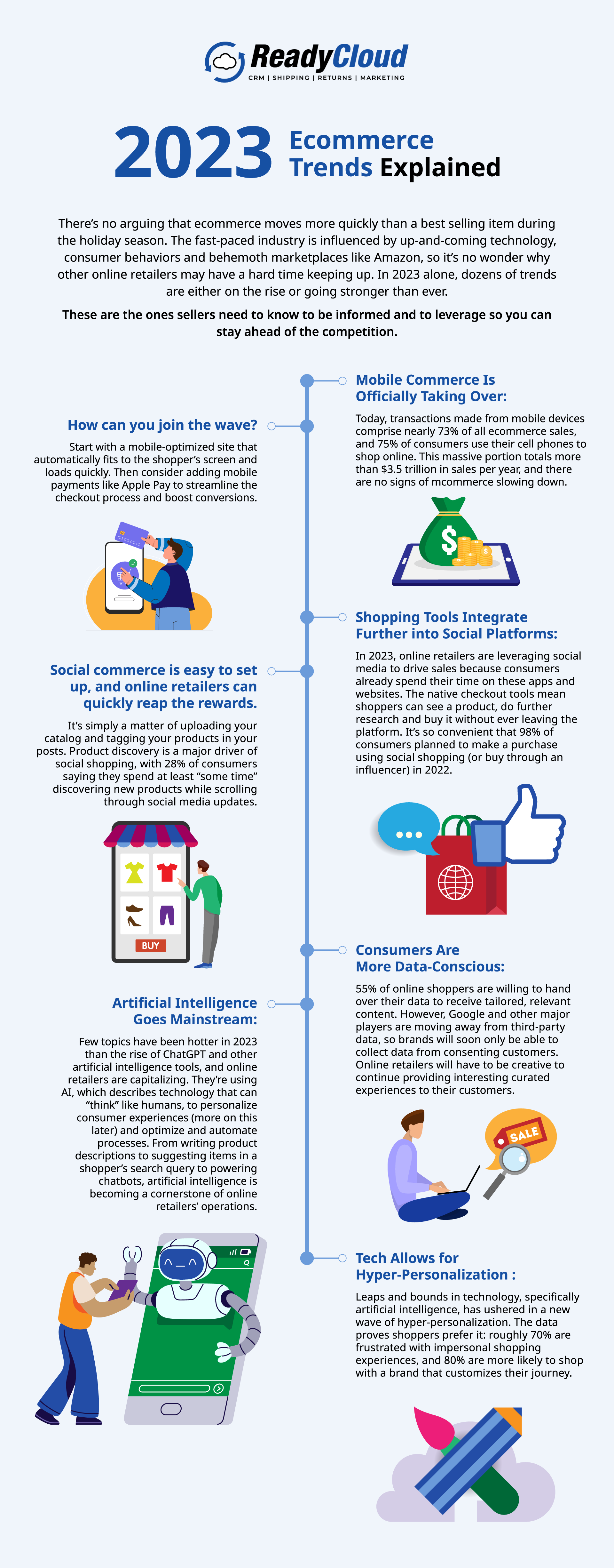2023’s Ecommerce Trends Explained

There’s no arguing that ecommerce moves more quickly than a best selling item during the holiday season. The fast-paced industry is influenced by up-and-coming technology, consumer behaviors and behemoth marketplaces like Amazon, so it’s no wonder why other online retailers may have a hard time keeping up. In 2023 alone, dozens of trends are either on the rise or going stronger than ever. If you’ve been following along, we’ve always tried to keep you up-to-date with our Trends reports, covering 2022, 2021, 2020, 2019, 2018 and 2017 in-depth.
Now it’s time to get you updated on this year’s trends. These are the ones sellers need to know to be informed and to leverage so you can stay ahead of the competition. Read on to learn more.
Mobile Commerce Is Officially Taking Over
It’s been nearly a decade since mobile commerce, or mcommerce, was poised to take over the online retail industry, and now the time is here. The ubiquity of cell phones, convenience of mobile shopping and integration of mobile payments have created the perfect storm for the rise of mobile commerce, which simply refers to any online shopping done from one’s mobile device.
Today, transactions made from mobile devices comprise nearly 73% of all ecommerce sales, and 75% of consumers use their cell phones to shop online. This massive portion totals more than $3.5 trillion in sales per year, and there are no signs of mcommerce slowing down.
How can you join the wave? Start with a mobile-optimized site that automatically fits to the shopper’s screen and loads quickly. Then consider adding mobile payments like Apple Pay to streamline the checkout process and boost conversions. And don’t miss our recent guide to mcommerce that proves it’s the future.
Shopping Tools Integrate Further into Social Platforms
Although social media platforms were once a place to share updates with friends and family, they quickly evolved into multipurpose digital spaces that brands could monetize. Shopping tools were introduced first to Pinterest and Facebook, but other platforms like Instagram and TikTok followed shortly thereafter, officially joining the social commerce revolution.
In 2023, online retailers are leveraging social media to drive sales because consumers already spend their time on these apps and websites. The native checkout tools mean shoppers can see a product, do further research and buy it without ever leaving the platform. It’s so convenient that 98% of consumers planned to make a purchase using social shopping (or buy through an influencer) in 2022.
Social commerce is easy to set up, and online retailers can quickly reap the rewards. It’s simply a matter of uploading your catalog and tagging your products in your posts. Product discovery is a major driver of social shopping, with 28% of consumers saying they spend at least “some time” discovering new products while scrolling through social media updates.
Consumers Are More Data-Conscious
Some consumers are content to provide their information in exchange for personalized experiences, but others are more data-conscious. They’re concerned about how their information is being used and if they’re being put at risk, and they’re more aware of their privacy rights in the digital age. This growing awareness among online shoppers is changing how ecommerce marketers are approaching demand generation and data collection.
On one hand, 55% of online shoppers are willing to hand over their data to receive tailored, relevant content. However, Google and other major players are moving away from third-party data, so brands will soon only be able to collect data from consenting customers. Online retailers will have to be creative to continue providing interesting curated experiences to their customers.
Online Shoppers Seek Offline Connection
The saying, “What’s old is new again,” is entirely true in the retail industry. Consumers are returning to brick-and-mortar stores (and click and mortar stores), seeking better prices (like skipping the shipping fees) and more captivating shopping experiences. And for sellers who can seamlessly create an omnichannel customer journey, an offline store or pop-up is the perfect place to build connections with customers and solidify your brand even for webroomers and showroomers.
This theme of IRL connection isn’t limited to stores that have a brick-and-mortar presence, however. Consumers are also seeking brands whose values align with their own and give back to their communities. Our friends at Shift4Shop say ecommerce sellers need to, “Think global, act local” to deliver authenticity to customers. This could mean donating a portion of profits to regional charities or organizing volunteer days for your staff and customers to join if interested.
Artificial Intelligence Goes Mainstream
Few topics have been hotter in 2023 than the rise of ChatGPT and other artificial intelligence tools, and online retailers are capitalizing. They’re using AI, which describes technology that can “think” like humans, to personalize consumer experiences (more on this later) and optimize and automate processes. From writing product descriptions to suggesting items in a shopper’s search query to powering chatbots, artificial intelligence is becoming a cornerstone of online retailers’ operations.
Experts predict that we’re only scratching the surface of what AI can do in ecommerce. Future sellers will be able to leverage it for smarter inventory management, more tailored marketing and better customer relationship building.
Tech Allows for Hyper-Personalization
Today’s consumers are savvy, but one thing that won’t change is their desire to be seen and understood. Personalization has delivered on that need by curating customized brand interactions for shoppers, most notably by recommending products based on their browsing and purchase behavior. But the leaps and bounds in technology, specifically artificial intelligence, has ushered in a new wave of hyper-personalization. The data proves shoppers prefer it: roughly 70% are frustrated with impersonal shopping experiences, and 80% are more likely to shop with a brand that customizes their journey.
Our latest guide to ecommerce personalization is full of ideas for how online retailers can add a personal touch to the customer journey and boost sales and retention in the process.
Even More 2023 Ecommerce Trends to Know
Kept up so far? There’s a lot of information out there, but that means you can pick and choose the ways you want to update your online store and follow the trends.
It’s easy to get overwhelmed in the rapidly evolving ecommerce space, so we’ve put together a few guides so you can read up on the trends that are still going strong:

Share On:







